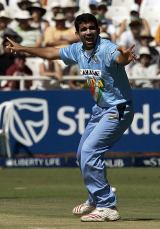
|

Zaheer Khan was dynamite with the new ball at Newlands, at the slog he was poor
© AFP
|
|
For more than half the innings in the third one-dayer at Newlands, it was a near-impeccable bowling display. Zaheer Khan provided the incisions at the top of the order and Anil Kumble tightened the noose with his legspin. But in the final 10 overs, near-perfect became perfectly abysmal as Justin Kemp and Andrew Hall ravaged the bowling for 113 runs. Kemp smashed seven sixes, and Zaheer's last two overs went for 31 in an unforgettable display of power-hitting.
If it had been a one-off, it could have been dismissed as an aberration. After all, the South African batsmen had clobbered 96 from 9.5 overs against Australia as they overhauled 434 at the Wanderers in March. But India have a history when it comes to late-overs ineptitude, and a failure to finish teams off.
At Newlands, they had South Africa 76 for 6, and allowed them to escape to 274. A couple of months earlier in Kuala Lumpur, with a place in the DLF Cup final at stake, they had Australia reeling at 117 for 6, only for the last four wickets to add 96 on a surface where run-scoring was never easy. The same bowlers who had appeared so menacing and incisive in their opening spells got hammered late in the innings, with barely a yorker finding its target.
The yorker, whether reverse-swung or otherwise, has been an integral part of the problem. Munaf Patel bowled it beautifully on Test debut at Mohali against England, but has found it difficult to do the same with the white ball. And the attempts to pitch full in Cape Town played straight into Justin Kemp's hands, with his devastating straight swings sending the ball soaring over the fence.
As Brett Lee and several others have shown often enough the fast, well-directed, swinging yorker is an invaluable weapon at the denouement of a one-day innings. But it's also a delivery that leaves no margin for error. Get it wrong, and a potentially wicket-taking ball becomes a full toss, and a free hit for a batsman.

|

Bowling Anil Kumble at the slog could be a temporary option
© AFP
|
|
The cleverly disguised change of pace is an equally potent delivery, but there too India's bowlers have a way to go to attain Steve Waugh or Dwayne Bravo standards. Bowling length balls with barely a variation in pace is a recipe for disaster, and once Kemp started teeing off, India had no answers.
The magnitude of the problem is best illustrated by figures. In 80 innings since the last World Cup, India conceded 4358 runs between the 41st and 50th overs. They took 173 wickets at 25.19 and leaked 6.44 per over. In the same time-frame, Australia also bowled in 80 innings, picking up 196 wickets at 20.07 and conceded 6.05 per over.
Since Manoj Prabhakar was eased out of the game by Sanath Jayasuriya's strokeplay at the 1996 World Cup, India have struggled to find someone adept at bowling at the death. Ajit Agarkar and Zaheer are the most experienced in the end overs, but neither has been as effective as they can be with the new ball. The new crop have also learnt the hard way. Munaf and Sreesanth bowled beautifully initially in the warm-up match against Rest of South Africa at Benoni, but once Albie Morkel and Jacques Rudolph decided to open out, they were clueless.
Turning to Kumble and spin might be a short-term answer, but with modern-day batsmen using such heavy bats, even a mis-hit could comfortably clear the rope. In the biggest game that India have played in recent memory, Ricky Ponting and Damien Martyn walloped 109 from the final ten overs of the World Cup final, effectively ending it as a contest. Once or twice, Ponting lofted the ball one-handed, such was the wretched bowling on display. To avoid repeats of that fiasco and the Cape Town one, India have to find answers to an issue that could replace Fermat's Last Theorem as the problem no one can solve
Click here to send us your feedback on this article.
Dileep Premachandran is features editor of Cricinfo

